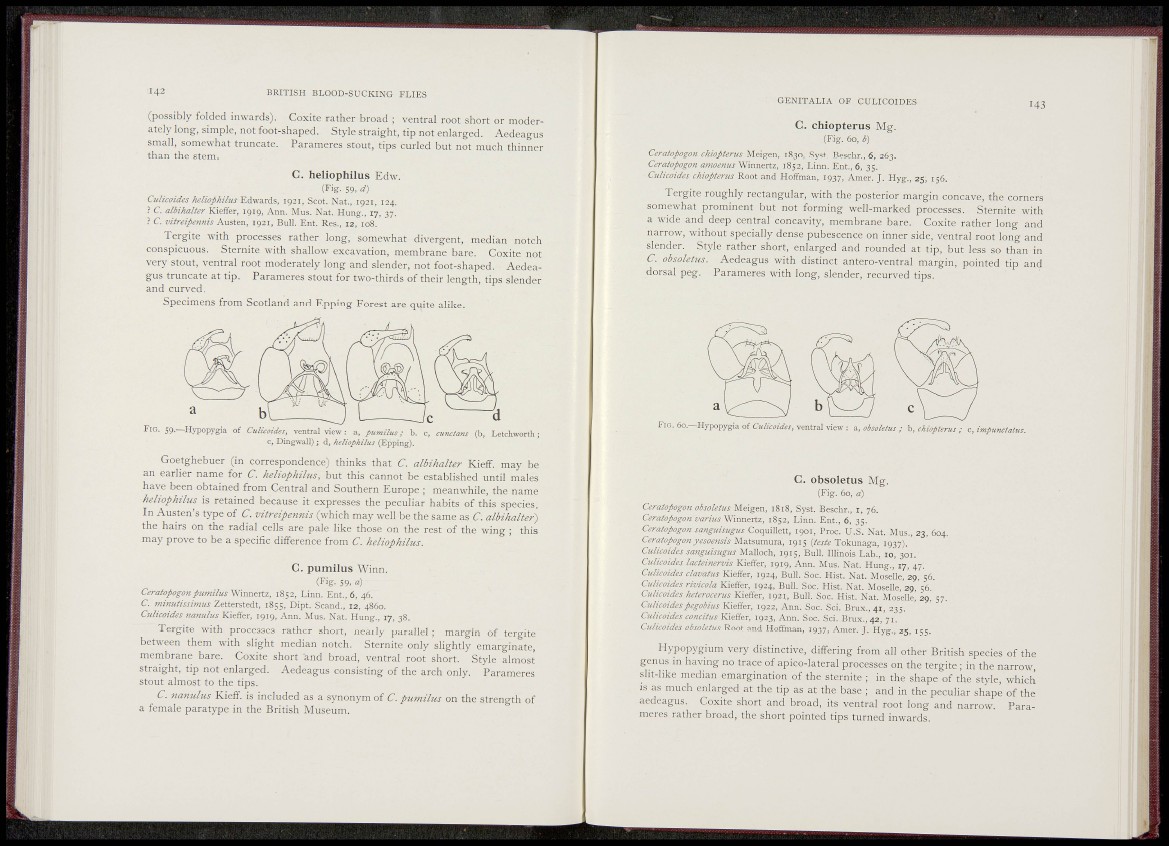
142 BRITISH BLOOD-SUCKING FLIES
(possibly folded inwards). Coxite rather broad ; ventral root short or moderately
long, simple, not foot-shaped. Style straight , tip not enlarged. Aedeagus
small, somewhat truncate. Parameres stout, tips curled but not much thinner
t h a n the stem.
C. heliophilus Edw.
(Fig. 59,
CuHcoides }wlioJ)hilus 'EA\\arAs, 1921, Scot. Nat., 1921, 124.
? C. albihalter Kieffer, 1919, Ann. Mus. Nat. Hung., 17, 37.
? C. vitreipemiis Austen, 1921, Bull. Ent. Res., 12, 108.
Tergite with processes rather long, somewhat divergent, median notch
conspicuous. Sternite with shallow excavation, membrane bare. Coxite not
very stout, ventral root moderately long and slender, not foot-shaped. Aedeagus
truncate at tip. Parameres stout for two-thirds of their length, tips slender
and curved.
Specimens from Scotland and Epping Forest are quite alike.
FIG. 59._Hj'popygia of Culicoides, ventral view: a, pumilus; b. c, cunctans (b, Letchworth;
c, Dingwall) ; d, heliophilus (Epping).
Goetghebuer (in correspondence) thinks that C. albihalter Kiefif. may be
a n earlier name for C. heliophilus, but this cannot be established until males
have been obtained from Central and Southern Europe ; meanwhile, the name
heliophilus is retained because it expresses the peculiar habits of this species.
I n Austen' s type of C. vitreipennis (which may well be the same as C. albihalter)
t h e hairs on the radial cells are pale like those on the rest of the wing ; this
may prove to be a specific difference f rom C. heliophilus.
C. pumilus Winn.
(Fig- 59, a)
Ceralopog-onpumz/us Winneitz, 1852, Linn. Ent., 6, 46.
C. mlnutissimiis Zetterstedt, 1855, Dipt. Scand., 12, 4860.
Culicoides 7mnulus Kieffer, 1919, Ann. Mus. Nat. Hung., 17, 38.
T e r g i t e with processes rather short, nearly parallel ; margin of tergite
between them with slight median notch. Sternite only slightly emarginate,
membrane bare. Coxite short and broad, ventral root short. Style almost
s t r a i g h t , tip not enlarged. Aedeagus consisting of the arch only. Parameres
stout almost to the tips.
C. 7tanulus Kieff. is included as a synonym of C. pmnilus on the strength of
a female paratype in the British Museum.
GENITALIA OF CULICOIDES 143
C. chiopterus Mg.
(Fig. 60, b)
Ceratopogon chiopterus Meigen, 1830, Syst. Beschr., 6, 263.
Ceratopogon amoejius'^mxiHixiz, 1852, Linn. Ent., 6, 35.
Culicoides chiopterus Root and Hoffman, 1937, Amer. J. Hyg., 25, 156.
Tergite roughly rectangular, with the posterior margin concave, the corners
somewhat prominent but not forming well-marked processes. Sternite with
a wide and deep central concavity, membrane bare. Coxite rather long and
narrow, without specially dense pubescence on inner side, ventral root long and
slender. Style rather short, enlarged and rounded at tip, but less so than in
C. obsoletus. Aedeagus with distinct antero-ventral margin, pointed tip and
dorsal peg. Parameres with long, slender, recurved tips.
FIG. 6o,~Hypopygia of Culicoides, ventral «ew : a, obsoletus ; b, chiopterus ; c, impunctatus.
C. obsoletus Mg.
(Fig. 60, a)
Ceratopogon obsoletus Meigen, 1818, Syst. Beschr., i, 76.
Ceratopogon varius Winnertz, 1852, Linn. Ent., 6, 35.
Ceratopogon sanguisugus Coquillett, 1901, Proc. U.S. Nat. Mus., 23, 604.
Ceratopogonyesoensis Matsumura, 1915 {teste Tokunaga, 1937).
Culicoides sanguistigus Malloch, 1915, Bull. Illinois Lab., 10, 301.
Culicoides lacteinervis Kieffer, 1919, Ann. Mus. Nat. Hung., 17, 47.
Culicoides clavatus Kieffer, 1924, Bull. Soc. Hist. Nat. Mose'lle, 29, 56.
Culicoides rivicola Kieffer, 1924, Bull. Soc. Hist. Nat. Moselle,'29,'56
Culicoides hetcrocerus Kieffer, 1921, Bull. Soc. Hist. Nat. Moselle,' 29, 57.
Culicoidespegobius Kieffer, 1922, Ann. Soc. Sei. Brüx., 41, 235.
Culicoides concitus Kieffer, 1923, Ann. Soc. Sei. Brüx., 42,'71 •
Culicoides obsoletus Root and Hoffman, 1937, Amer. J. Hyg., 25, 155.
H y p o p y g i um very distinctive, differing from all other British species of the
genus in having no trace of apico-lateral processes on the tergite ; in the narrow,
s h t - h k e median emargination of the sternite ; in the shape of the style, which
IS as much enlarged at the tip as at the base ; and in the peculiar shape of the
aedeagus. Coxite short and broad, its ventral root long and narrow. Parameres
rather broad, the short pointed tips turned inwards.
11 llif -